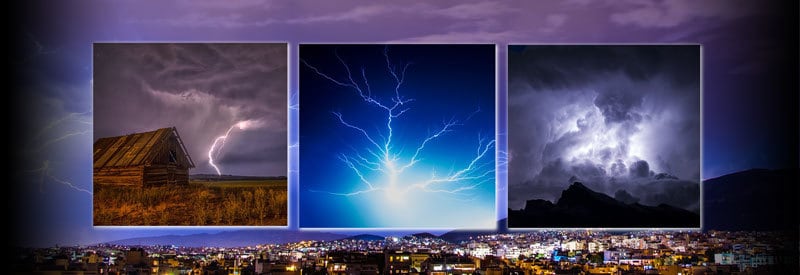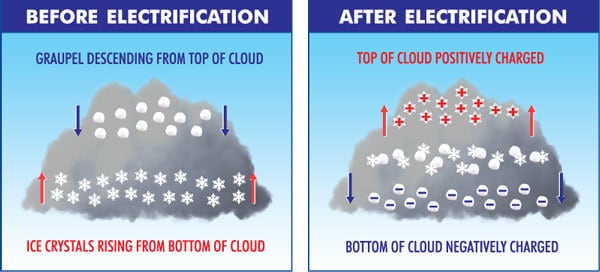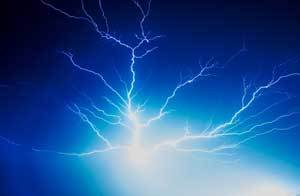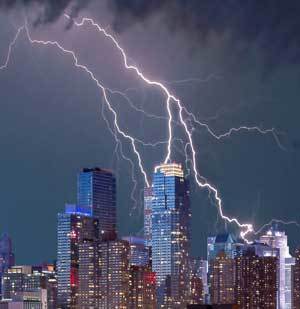Defining A Lightning Bolt, How It Occurs, And The Effects Of Lightning On The Environment

The majority of readers have already seen a lightning strike during a thunderstorm, either in person, online, or on a television screen. We examine this phenomenon, how it occurs, and its effects.
Even if you never personally experienced a lightning storm before, you most certainly would have seen it on television, online, or even in the movies. This is one of nature's most spectacular and potentially deadly displays.
Lightning Bolt Definition
A lightning strike or bolt can be defined as a bright flash that occurs due to the instant, powerful electrical discharge of a high-voltage current between two points in a thundercloud. It can occur during a thunderstorm between a cloud and the ground, two different clouds, or within a single cloud.
The short summary above only provides a glimpse of what actually takes place between the different elements in the atmosphere to produce this powerful phenomenon.
Few of us, however, know how this phenomenon occurs and what causes it. In this article, we look at what precisely lightning is, how it is formed, and examine other aspects of this powerful force of nature.
What Causes Lightning?
We already know that lightning is basically a very rapid and powerful discharge of electrical energy. But what causes such a huge electrical current to form in the first place?
The answer lies in the movement of particles that are formed within a cloud. More specifically, the movement of ice crystals, graupel, and supercooled water.
After moist air has risen high enough to cool down and condensation takes place, cloud formation takes place. This process alone is not enough to produce lightning.
In a cloud where strong updrafts are present, water droplets are carried high up into the cloud formation, where it cools down to temperatures below freezing point.
This usually occurs in a storm cloud like a cumulonimbus cloud, which is characterized by both extensive vertical development and strong updrafts.

The Buildup Of An Electrical Charge In A Cloud That Results In A Lightning Strike
As a result of the low temperatures combined with the strong updrafts, a mixture of ice crystals, graupel, and supercooled water can form.
Graupel is heavier than the much finer ice crystals. As a result, the lighter ice crystals are carried upwards in the cloud, while the heavier graupel starts to fall towards the ground.
(You can find out all about ice crystals and graupel and how they are formed in this article.)
When the rising ice crystals meet the falling graupel, a collision between the two takes place, and electrons are stripped off in the process. This causes the ice crystals to be positively charged, while the graupel receives a negative charge.
Negatively charged graupel now starts to accumulate at the bottom of the cloud while the top of the cloud gets saturated with positively charged ice crystals. In the early stage of this "electrification" of the cloud, the atmosphere act as an insulator between the two charges.
Video (courtesy of National Geographic) illustrating what a lightning strike is and how it occurs.
The electrical charge continues to grow and strengthen as the cloud becomes more saturated with negatively charged graupel at the bottom and positively charged ice crystals at the top of the cloud.
As soon as the charge becomes too strong for the atmosphere to continue to insulate the two electrical poles, a sudden and violent release of energy occurs. The resulting bright flash and thundering sound you hear is the actual electrical discharge we know as lightning.
Characteristics Of A Lightning Strike
You now know what causes a lightning strike and that a substantial amount of static electricity needs to build up for such a powerful discharge to occur. Just how much electricity is generated will explain much of the characteristics of lightning.

One lightning bolt alone can discharge up to one billion volts of electrical energy. To put this in practical terms, this is enough to power a 100-watt lightbulb for three months. This will explain why a lightning strike is able to light up the sky, even during the middle of the day.
The electrical discharge is not only powerful but also generates a lot of heat. In fact, a lightning bolt can heat up the surrounding air by up to 30 000° Celsius (54 000° Fahrenheit). This temperature is roughly five times hotter than the surface of the sun.
When people talk about a thunder and lightning storm, they are actually talking about the same occurrence. The thunder we hear during a lightning storm is nothing more than the sound generated by the discharge of electrical energy during a lightning strike.
This simply means that when we talk about thunderstorms or a thunder cloud, technically we are referring to a byproduct of a lightning bolt. For all intents and purposes, all these occurrences are lightning strikes.
Types Of Lightning
Depending on what you read or who you talk to, there can be a long list of different types of lightning that occur under various circumstances. However, all lightning bolts that are the result of an electrical discharge in a cloud can be classified into three main categories:
- Intracloud (IC) Lightning
- Cloud-To-Cloud (CC or Inter-Cloud) Lightning
- Cloud-To-Ground (CG) Lightning
Some of these three main types of lightning groups contain a variety of subcategories. While describing the lightning strikes that are characteristic of each main category, we will also take a look at a few of the more significant and noteworthy subcategories.
1) Intracloud (IC) Lightning
Intracloud lightning occurs when an electrical discharge occurs between the positive and negative poles within a single cloud once the atmosphere can no longer act as an insulator between the two charges.
This is by far the most common form of lightning, accounting for roughly three-quarters of all lightning strikes. As a result, the majority of lightning never leaves a cloud system.
It is also known as sheet lightning due to its ability to light up an entire cloud, giving it the appearance of a big white sheet with a bright light behind it.
2) Cloud-To-Cloud (Inter-Cloud) Lightning
Inter-Cloud lightning occurs when the electrical discharge occurs between the positive pole of one independent cloud and the negative pole of another independent cloud.
Like intracloud lightning, it is also known as sheet lightning due to its ability to light up an entire cloud system.
Intracloud and inter-cloud lightning are collectively called cloud flashes as the lightning occurs within and around a cloud system, lighting up the whole area for a split second.
3) Cloud-To-Ground (CG) Lightning
Cloud-To-Ground lightning is the form of lightning we are most familiar with and usually also produces the most spectacular display. This form of lightning occurs when the electrical discharge occurs between the bottom of the cloud and objects on the surface of the ground.

Usually, the negatively charged bottom half of the cloud is responsible for the surface of the ground below it becoming charged with positive ions. The positively charged area on the surface basically "follows" the storm cloud around.
Once the electrical poles become too strong, a powerful negative charge (called a step leader) shoots down and makes contact with a positively charged object on the ground (called a positive streamer) reaching up.
When the two connect, a strong discharge occurs with a loud cracking sound. This causes a powerful and violent current, resulting in a return stroke, racing back to the cloud at 60 000 miles per second. The return stroke is the bright flash we observe as a lightning strike.
Effects Of Lightning
A bolt of electricity five times hotter than the surface of the sun, carrying up to a billion volts of electricity, and traveling at 60 000 miles per second, is bound to have a significant effect on any objects it comes in contact with on the ground.
Now take into consideration the fact that the earth gets hit by lightning a hundred times every second. That is eight million times per day. With so much power on display at such a frequent rate, its effects need to be taken very seriously.
Lightning can have a direct and indirect effect on objects, causing varying levels of injury and damage. This is a topic for another article, but here are just a few examples:
1) Direct Lightning Strikes
Although nine out of ten people hit by lightning survive, they may still suffer long-term injuries. This includes burn injuries, cardiac-related health issues, and damage to the nervous system. The same type of injuries can be applied to animals.
Vegetation also risks damage from a direct lightning strike. The rapid expansion of moisture can blow the bark off a tree. The heat from a strike can also cause forest fires, and the instant heating of water in a rock can cause it to shatter.
Infrastructure can also be seriously damaged by lightning. It can shatter concrete, bricks, and stone, causing severe damage to buildings. A direct strike can also destroy all electrical equipment within a structure.
2) Indirect Lightning Strikes
Electrical and electronic equipment is very vulnerable to an indirect lightning strike. Hitting a nearby substation or power-line can cause a dramatic surge in your electricity supply, potentially damaging or completely destroying electrical/electronic equipment.
Indirect Lightning can still be fatal. It is pure electricity, and any surface it hits can carry the electric current. In 2016, over 300 reindeer were killed by lightning that hit and traveled through the ground. This is also why it is so dangerous to stand underneath a tree during a lightning storm.
Conclusion
This article detailed what these spectacular lightning displays are that one sees captured on video, television, or experienced in real life. It also assisted in better understanding how this powerful phenomenon is created or formed in the first place.
But one will also be able to understand the power that lightning possess and the potential danger that comes with it. There is nothing wrong with admiring this wonder of nature, but neither is having a healthy dose of respect for it.
Never miss out again when another interesting and helpful article is released and stay updated, while also receiving helpful tips & information by simply clicking on this link .
Until next time, keep your eye on the weather!
